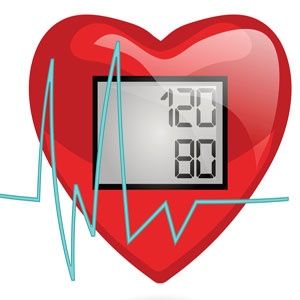
Alternative name: high blood pressure
Your blood pressure (BP) is the pressure within your blood vessels. This pressure is generated by the contraction of the heart and counteracted by the resistance of the small arteries. BP is essential to life. It keeps the blood flowing through your body and provides oxygen and energy to your organs.
Your BP is strictly regulated, as too low pressure causes dizziness, fainting, and a lack of oxygen to your organs. In fact, when a doctor uses the term “shock”, it usually implies that there’s been a drastic drop in blood pressure, leading to inadequate blood flow through the body (perfusion) and insufficient oxygenation of vital organs like the brain and kidneys.
Starved from their life-giving source of oxygen, these organs cannot function anymore, and you’re at risk of dying – unless corrective treatment is taken.
Too high BP (either systolic or diastolic or both – see below) may damage blood vessels and vital organs over time.
According to the World Health Organisation (WHO), there’s been a 67% increase in hypertension from 1990 to 2010 in Sub-Saharan Africa, and 40% of all adults are affected. In Africa, 18% of all deaths are related to hypertension, resulting in half a million deaths and 10 million years of lost life in 2010.
Furthermore, hypertension is without a doubt one of the leading causes of heart attack, stroke, kidney failure, dementia, eye disease and premature death. Together with cigarette smoking, high cholesterol, obesity and diabetes, it constitutes the so-called “cardiovascular risk profile”.
How does it work?
Your heart functions as a muscular pump that contracts rhythmically and pumps blood into your arteries.
From your heart, through your large vessels (such as the aorta), your blood is channelled to your entire body through a circulatory system of smaller vessels. All arteries are surrounded by smooth muscle that regulate BP. Constriction of the muscle in the arterial wall causes it to narrow, which increases the resistance – hence the pressure within.
This can be compared to taking a garden hose and reducing the size of the nozzle. Pressure in a hose can, of course, also be raised by increasing the amount of water flowing from the tap. Similarly, the amount of circulating blood, and the strength of the heart-muscle contractions, can also influence your BP.
Your BP increases and decreases according to the demands placed on it. This enables you to play a vigorous game of tennis and also get a good night’s sleep. BP rises when you’re active and falls when you’re inactive. During restful sleep, your inactivity reduces the demand for oxygen and, therefore, BP is usually lowest at night and highest when you get up in the morning.
There’s also considerable variability in BP throughout the day, and it may be transiently elevated under certain circumstances. This shouldn’t be confused with hypertension, which is a sustained elevation in blood pressure.
For instance, when you’re startled or threatened, your BP is raised through the effects of the “fight-or-flight” response, when your adrenaline levels are high. Experiencing pain can also raise BP dramatically. Furthermore, alcohol, nicotine and caffeine intake can cause transient elevations of BP.
BP fluctuations aren’t problematic unless very dramatic, and as long as your BP rapidly returns to a normal baseline. It’s a sustained increase in BP that causes havoc, especially when accompanied by risk factors like smoking, high cholesterol and obesity, and co-existing disease like diabetes.
Some people have high BP only in a medical establishment. This is termed “white coat” or “office” hypertension, and can be confirmed by showing that BP is normal in a home setting. This is done by means of home BP monitoring or 24-hour BP monitoring, where a device is worn for 24 hours.
It’s important to diagnose “white coating”, as treatment with antihypertensive drugs is unnecessary and can cause side effects. However, it’s important to recognise that some people with white coating may progress to sustained hypertension in time. These individuals must continue to monitor their BP on an annual basis.
Explaining blood pressure terminology
Hypertension is a condition in which the pressure within your arteries is consistently too high.
If your BP is too high, your heart must work much harder (and enlarges) to maintain adequate blood flow to your body. The long-term effects of this pressure may cause the heart to fail. This is termed hypertensive heart disease. In addition, high BP damages the arteries to the brain, heart, kidneys and eyes, resulting in complications like stroke, heart attack, kidney failure, visual problems, and even dementia.
A BP measurement is made up of two parts: systolic and diastolic pressure. Systolic pressure occurs in arteries during heart contraction (which is called a systole), while diastolic pressure occurs during the period of relaxation between beats. This is why a BP measurement is expressed as one figure "over" another, for example 120/80mmHg.
Systolic pressure is always higher than diastolic blood pressure. The measurement unit, millimetre mercury (symbol Hg), is derived from the distance that a column of mercury in the measurement instrument is pressed upward. If your BP is recorded as 120/80mmHg, the number on top is the systolic pressure, and the bottom number the diastolic. The optimal blood pressure is less than 120/80mmHg, although many people, especially young women, may have blood pressures as low as 90/60mmHg. This is quite normal.
Pulse pressure is the difference between the two readings. In elderly persons, the pulse pressure may rise because the systolic pressure rises and diastolic pressure falls (a result of the large vessels becoming stiff due to vascular ageing). This is called isolated systolic hypertension, and carries an even higher risk of complications. Although the diastolic may be “normal” or even low, it’s essential to get treatment for this type of hypertension.
When is blood pressure considered high?
Researchers are of the opinion that one’s average BP during the day shouldn’t exceed 130/80mmHg.
Hypertension is diagnosed when your BP is consistently above 140 systolic or 90 diastolic. Between 130/80mmHg and 140/90mmHg, it’s called high-normal BP. This is associated with increased risk, and usually progresses to hypertension over the next 2-5 years. It’s therefore essential to adopt lifestyle changes to reduce your risk and prevent the progression of BP.
The following table shows the normal ranges of BP and the stages of hypertension for South Africans. High-normal BP requires more regular monitoring. Stage 1 is less severe than Stage 3.
Blood pressure | Systolic (mmHg) | Diastolic (mmHg) |
NORMAL RANGE | ||
Optimal | 120 or less | 80 or less |
Normal | Less than 130 | Less than 80 |
High normal | 130 - 139 | 80 - 89 |
HYPERTENSION | ||
Stage 1 (Mild) | 140 - 159 | 90 - 99 |
Stage 2 (Moderate) | 160 - 179 | 100 - 109 |
Stage 3 (Severe) | 180 or higher | 110 or higher |
BP above 180/110mmHg is dangerous – you urgently need to get medical attention. If your BP is greater than 200/120mmHg, it can be rapidly life threatening and cause malignant hypertension.
Hypertension represents an arbitrarily determined level of BP, above which the advantages of treatment are greater than the disadvantages. Hypertension is diagnosed when BP measurements are above normal levels on two or more separate occasions, or by 24-hour BP monitoring.
In people who are at high cardiac risk, e.g. diabetics or individuals with known heart disease, treatment for BP may be indicated in the high-normal range.
Reviewed by Prof Brian Rayner, nephrologist and Director of the Hypertension Clinic, Groote Schuur Hospital. MBChB, FCP, MMed, PhD. May 2018.




 Publications
Publications
 Partners
Partners













